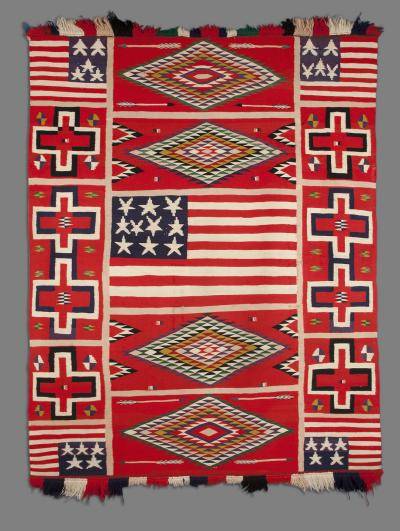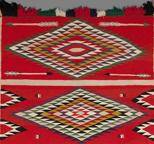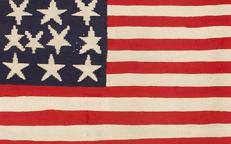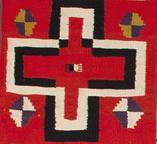
Eyedazzler Blanket/Rug
Artist not known, Navajo, United States
About 1885
Length: 71in. Width: 54 in.
Gift of Mrs. Charles Macallister Willcox, 1937.306
Photograph © Denver Art Museum 2012. All Rights Reserved.
This blanket/rug was likely the work of a female Navajo artist. Loom weaving was a woman’s art among the Navajos after they learned the skill from their Pueblo neighbors in the 1600s, but today both men and women weave.
Navajo weavers are justly famous for the excellence of their textiles. This style, known as an eyedazzler because of its vivid colors and dizzying design combinations, was popular during the later years of the Transitional period in Navajo weaving (1868–90), when artists began weaving for the tourist market rather than solely for home use. Brightly colored “Germantown” yarns, widely available through newly established trading posts on the Navajo Reservation, made it possible to produce these vibrant masterpieces.
During the Transitional period (1868–90) when this blanket/rug was created, Navajo weavers began to produce patterns compatible with the tastes of traders and patrons. Eyedazzler weavings are uniquely Navajo innovations, created to take advantage of a range of commercially made colors not previously available. In some ways you can think of these artists as testing a new product on a new audience.
Although this rectangular weaving is called a blanket or a rug, the decorative fringe and cotton warp (cotton is less durable than wool) suggest that its maker knew it was more likely to be displayed on a wall for decoration than to be used.
Details

The Bold Red
The red wool used throughout the background is a kind of commercially manufactured yarn called Germantown, named after a town in Pennsylvania that produced these yarns using synthetic dyes.

Saltillo Diamond
Navajo artists borrowed the serrated diamond motif from New Mexican Saltillo serapes. The Navajo people became familiar with the motif when they were incarcerated at Bosque Redondo in New Mexico (1863–68), where they received Saltillo-style blankets from the United States government.

Flags
Five flags appear in this eyedazzler. Notice how the artist used them to mimic the look of the American flag but not duplicate it exactly. Navajo weavers of this time often used flags in their textiles as design elements to appeal to non-Navajo customers.

Crosses
Artists often included cross-shaped designs in their eyedazzlers. Despite the obvious association with Christianity, these designs may have been derived from traditional Navajo women’s dresses.
More Resources
Colorado and the West: Native American History in Colorado
American Indian leaders from various cultural backgrounds talk about American Indian contributions to Colorado history, as well as the contermporary reality of American .
Sadie Curtis: Navajo Weaver
In this video, Navajo weaver Sadie Curtis talks about how she learned to weave rugs, and shows her weaving a rug—she says that she became well-known after she wove a rug depicting the U.S. flag.
Website
Blanket Navajo
This website presented by the University of Arizona gives a brief description of eye dazzlers from the 19th century.
Bruce Museum: The Navajo Weaving Tradition
This article offers a brief overview of Navajo weaving history
Hearst Art Gallery Saint Mary's College: Stories Woven In: the Navajo Way of Seeing
The article discusses the possible hidden meanings within Navajo weaving tradition.
Books
Kent, Kate Peck. Navajo Weaving. New Mexico: School of American Research Press, Santa Fe, 1985.
This book covers Navajo weaving. A history of Navajo weaving can be found on pages 77-79.
Bennett, Noël, and Tiana Bighorse. Navajo Weaving Way: The Path from Fleece to Rug. Loveland, CO: Interweave Press, 1997.
Shows the process and tools used in Navajo weaving: from shearing the sheep until the final product.
A Burst of Brilliance: Germantown Pennsylvania and Navajo Weaving. Pennsylvania: Trustees of the University of Pennsylvania, 1994.
Catalogue of an exhibition of Navajo Germantown’s/Eyedazzlers. It is filled with great images of these blankets.
Berlant, Anthony, and Mary Hunt Kahlenberg. Walk in Beauty: The Navajo and Their Blankets. New York: Little Brown and Company, 1977.
Navajo Heritage and their rugs and blankets. Information on Eyedazzlers can be found on pages 131-135 with images throughout the following pages.
Knowles, Gerald M. The Navajo of North America. Minneapolis: Lerner Publications, 2003.
A photographic illustration of the history and culture of the Navajo, including contemporary culture.
Max, Jill, ed. Spider Spins a Story: Fourteen Legends from Native America. Rising Moon Publishing, 1998.
This compilation of Native American stories includes “The Legend of the Moon,” a Navajo tale.
Oughton, Jerrie and Lisa Desimini. The Magic Weaver of Rugs: A Tale of the Navajo. Boston: Houghton Mifflin, 1994.
A beautifully illustrated version of the legend of how Navajos came to weave.
Pasqua, Sandra M.The Navajo Nation. Mankato, MN: Bridgestone Books, 2000.
A colorful introduction to contemporary clothing, houses, tribal industry, and ceremonies of the Navajo, including a bibliography for further reading.
Roessel, Monty. Kinaaldá: A Navajo Girl Grows Up. Minneapolis: Lerner Publications, 1993.
A book about the coming-of-age ceremony for Navajo girls.
Woven by the Grandmothers: Nineteenth-Century Navajo Textiles from the National Museum of the American Indian. Washington, DC: NMAI and Smithsonian Institution Press, 1996.
Documents one of the largest and most comprehensive collections of Navajo wearing blankets in the world.
Children’s Books
Blood, Charles L., Martin A. Link, Illustrated by Nancy Winslow Parker. The Goat in the Rug. New York, NY: Aladdin, 1990.
This is a story about friendship and cooperation. Geraldine is a goat and Glenmae is a young Navajo weaver. One day, Glenmae decides to weave Geraldine into a rug. The reader will learn about the process of weaving about the care and pride involved in the Navajo rug making tradition.
Roessel, Monty. Songs from the Loom: A Navajo Girl Learns to Weave. Minneapolis: Lerner Publications, 1995.
The author tells the story of his daughter, Jaclyn, learning to weave from her grandmother, Nali Ruth. Traditional stories and facts about the Navajo are interspersed throughout the step-by-step explanations and photographs of the weaving process. Appropriate for ages 9-12.
King, David C. The Navajo. Terrytown, New York: Marshal Cavendish Corporation: 2006.
Overview of Navajo culture by showing aspects of Navajo daily life past and present.
Bruchac, Joseph. Navajo Long Walk: The Tragic Story of a Proud People’s Forced March from Their Homeland. Washington DC: National Geographic Society, 2002.
Story of the Navajo Nation’s removal from their homelands in the 1800’s and the events leading up to it. Beautifully illustrated.
Rosinsky, Natalie M. The Navajo. Minneapolis, Minnesota: Compass Point Books, 2005.
History and present day life of Navajo People; weaving found pages 27-28.
Funding for object education resources provided by a grant from the Morgridge Family Foundation. Additional funding provided by the William Randolph Hearst Endowment for Education Programs, and Xcel Energy Foundation. We thank our colleagues at the University of Denver Morgridge College of Education.
The images on this page are intended for classroom use only and may not be reproduced for other reasons without the permission of the Denver Art Museum. This object may not currently be on display at the museum.
